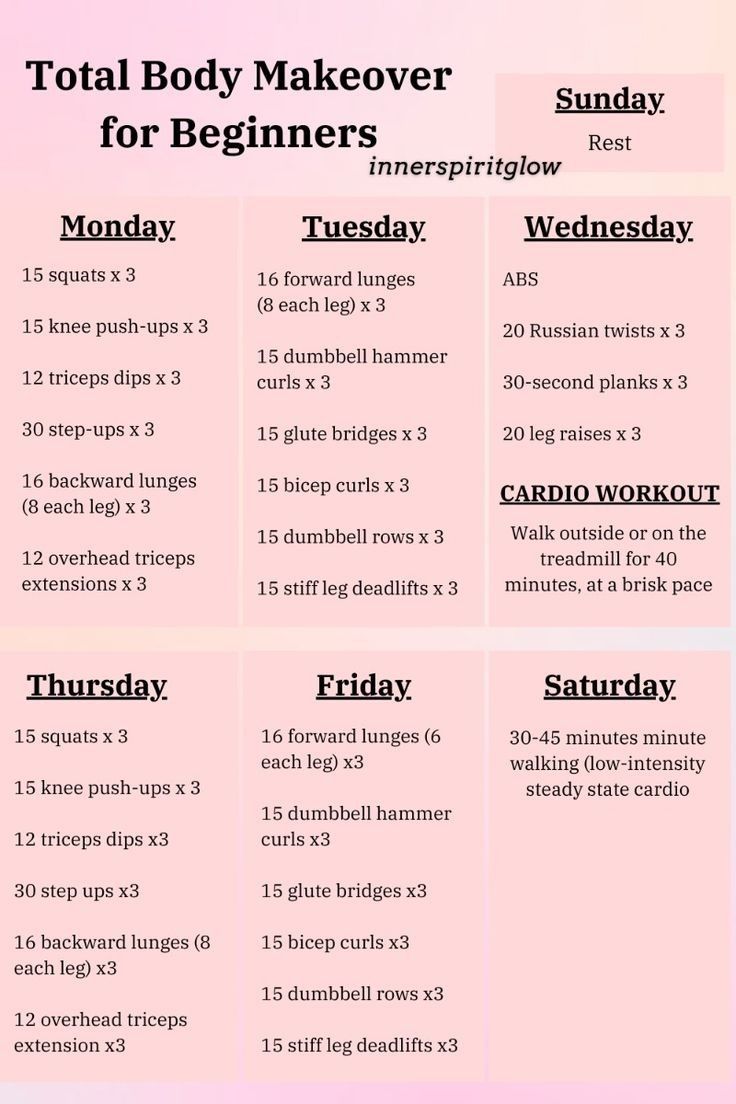Total Body Makeover for Beginners: A Comprehensive Weekly Workout Plan
If you’re looking for a straightforward way to start your fitness journey and achieve a full-body transformation, this beginner-friendly workout schedule might be exactly what you need. Designed to gradually build strength, improve flexibility, and bolster cardiovascular health, this program focuses on consistency and balanced exercise. Below, you’ll find a detailed breakdown of each day of the week, along with practical tips and insights on how to maximize each exercise session.Table of Contents
- Why a Total Body Makeover for Beginners?
- How to Get Started
- Weekly Schedule Overview
- Detailed Exercise Descriptions and Tips
- Frequently Asked Questions (FAQs)
- Additional Tips for Success
- Final Thoughts
Why a Total Body Makeover for Beginners?
Embarking on a fitness journey for the first time can be both exciting and intimidating. A well-rounded workout routine:
- Builds a solid foundation of strength and endurance.
- Targets major muscle groups to ensure balanced development.
- Promotes cardiovascular health, which supports overall well-being.
- Encourages consistency, the most important factor for seeing long-term results.
- Prevents boredom, as each day offers variety in movements and muscle groups.
Because this program is designed specifically for beginners, the exercises included are relatively simple, focusing on bodyweight and light dumbbell exercises. These moves are low-impact enough to minimize injury risks but still challenging enough to help you build muscle tone and shed extra body fat over time.
How to Get Started
Before diving into any new workout routine, it’s essential to:
- Consult a healthcare professional: Especially if you have any pre-existing conditions, injuries, or concerns.
- Gather essential equipment: This routine suggests dumbbells for arm exercises (like bicep curls, hammer curls, dumbbell rows). Choose a pair that feels moderately challenging for you—heavy enough to feel muscle engagement, but light enough to maintain proper form.
- Prepare a workout space: Ensure you have sufficient room to lunge, squat, and step up safely.
- Stay hydrated and fueled: Proper nutrition and hydration are key to optimal performance.
- Set realistic goals: Define short-term and long-term fitness goals to keep you motivated and on track.
Weekly Schedule Overview
Below is the suggested workout schedule. The idea is to alternate between strength-building and cardio-based exercises while ensuring adequate recovery time. You’ll notice that Monday’s routine is repeated on Thursday, and Tuesday’s routine is repeated on Friday. This approach allows your muscles to adapt to the exercises, improving form and performance over time.
Monday: Lower Body & Upper Body Basics
- Squats – 15 reps x 3 sets
- Knee Push-Ups – 15 reps x 3 sets
- Tricep Dips – 12 reps x 3 sets
- Step-Ups – 30 reps x 3 sets (15 per leg)
- Backward Lunges – 16 reps x 3 sets (8 per leg)
- Overhead Tricep Extensions – 12 reps x 3 sets
Focus: On Monday, you’ll be challenging your lower body with squats, step-ups, and lunges, while knee push-ups, tricep dips, and overhead tricep extensions target your chest and arms. Remember to control your movement and maintain proper form.
Tuesday: Compound Moves and Strength Training
- Forward Lunges – 16 reps x 3 sets (8 per leg)
- Dumbbell Hammer Curls – 15 reps x 3 sets
- Glute Bridges – 15 reps x 3 sets
- Bicep Curls – 15 reps x 3 sets
- Dumbbell Rows – 15 reps x 3 sets
- Stiff-Leg Deadlifts – 15 reps x 3 sets
Focus: Tuesday’s workout emphasizes compound exercises that recruit multiple muscle groups at once, such as forward lunges and stiff-leg deadlifts for lower body and back, plus targeted arm exercises (bicep curls, hammer curls) to continue building upper body strength.
Wednesday: Core and Cardio Challenge
- Russian Twists – 20 reps x 3 sets
- Planks – 30 seconds x 3 sets
- Leg Raises – 20 reps x 3 sets
- Cardio Workout: 40-minute brisk walk (outside or on a treadmill)
Focus: Wednesdays are all about strengthening your midsection and boosting heart health. Russian twists, planks, and leg raises target your core muscles. A 40-minute brisk walk is an accessible form of cardiovascular exercise that supports fat loss and improves endurance.
Thursday: Repeat Monday’s Routine
- Squats – 15 reps x 3 sets
- Knee Push-Ups – 15 reps x 3 sets
- Tricep Dips – 12 reps x 3 sets
- Step-Ups – 30 reps x 3 sets
- Backward Lunges – 16 reps x 3 sets
- Overhead Tricep Extensions – 12 reps x 3 sets
Focus: By Thursday, you’ll likely notice improved form and confidence in these movements. Repeating Monday’s workout helps refine technique and consistency in lower-body and tricep-focused exercises.
Friday: Repeat Tuesday’s Routine
- Forward Lunges – 16 reps x 3 sets (6 each leg)
- Dumbbell Hammer Curls – 15 reps x 3 sets
- Glute Bridges – 15 reps x 3 sets
- Bicep Curls – 15 reps x 3 sets
- Dumbbell Rows – 15 reps x 3 sets
- Stiff-Leg Deadlifts – 15 reps x 3 sets
Focus: Tackle Friday with the same determination as Tuesday. Pay attention to your posture, especially on the stiff-leg deadlifts, and challenge yourself to maintain consistent and controlled movements.
Saturday: Low-Intensity Steady-State Cardio
- 30-45 minutes of walking at a moderate pace
Focus: Low-intensity steady-state (LISS) cardio is an excellent way to burn calories without overstraining your muscles. This keeps your body active and supports cardiovascular health without the intensity of sprints or HIIT workouts.
Sunday: Rest and Recovery
- Rest or engage in light stretching, yoga, or gentle mobility work.
Focus: Rest is critical for muscle recovery, hormone regulation, and overall well-being. Use this day to prepare mentally for the upcoming week. If you’re craving movement, opt for light activities like yoga or stretching to enhance flexibility and reduce muscle tension.
Detailed Exercise Descriptions and Tips
- Squats
- How to do it: Stand with feet hip-width apart, lower your hips back and down while keeping your chest upright.
- Pro tip: Keep your heels grounded and push through them to rise.
- Knee Push-Ups
- How to do it: Start in a modified plank position on your knees, lower your chest to the floor while keeping your core tight.
- Pro tip: Maintain a straight line from shoulders to knees to avoid arching your back.
- Tricep Dips
- How to do it: Use a stable chair or bench. Place your hands behind you, fingers pointing forward, and lower your body by bending your elbows.
- Pro tip: Keep your elbows tucked close to your torso, and do not let them flare out.
- Step-Ups
- How to do it: Using a sturdy step or bench, step one foot up, then bring the other up. Step back down with control.
- Pro tip: Drive through the heel of the leading foot for better glute engagement.
- Backward Lunges
- How to do it: Step one foot back into a lunge, bend both knees to about 90 degrees, then return to starting position.
- Pro tip: Keep your front knee aligned over the front ankle, not collapsing inward.
- Overhead Tricep Extensions
- How to do it: Hold one dumbbell behind your head, elbows pointing upward, and extend your arms.
- Pro tip: Keep your core engaged and avoid arching your lower back.
- Forward Lunges
- How to do it: Step one foot forward, lower yourself into a lunge, and push off the front foot to return.
- Pro tip: Focus on balance. If you’re wobbly, do them slower or hold onto a stable surface.
- Dumbbell Hammer Curls
- How to do it: Hold dumbbells with your palms facing in (neutral grip), bend your elbows, bringing weights up toward your shoulders.
- Pro tip: Keep your elbows tight to your torso; avoid swinging the dumbbells.
- Glute Bridges
- How to do it: Lie on your back, feet on the floor, knees bent. Lift your hips up until your body forms a straight line from shoulders to knees.
- Pro tip: Squeeze your glutes at the top of the movement, and keep your core braced.
- Bicep Curls
- How to do it: Hold dumbbells with palms facing forward, curl them up toward your shoulders.
- Pro tip: Exhale as you curl up, inhale as you lower. Keep the motion slow and controlled.
- Dumbbell Rows
- How to do it: Hinge forward at the hips, keep your back straight, and pull the dumbbells up toward your torso.
- Pro tip: Squeeze your shoulder blades together at the top of each rep to target your back muscles effectively.
- Stiff-Leg Deadlifts
- How to do it: Stand with feet hip-width apart, hold dumbbells in front of your thighs, hinge at your hips, lowering the weights toward your shins.
- Pro tip: Keep your back neutral and a slight bend in the knees. Feel the stretch in your hamstrings.
- Russian Twists
- How to do it: Sit on the floor, lean back slightly, lift your feet off the ground, and rotate your torso side to side.
- Pro tip: For added intensity, hold a light weight or medicine ball.
- Planks
- How to do it: Get into a push-up position or forearm plank. Keep your spine neutral, and hold for the prescribed time.
- Pro tip: Engage your core and glutes to prevent your hips from sagging.
- Leg Raises
- How to do it: Lie on your back, hands under your hips for support, and lift your legs while keeping them straight.
- Pro tip: Exhale as you lift, inhale as you lower. Keep your lower back pressed to the floor for support.
- Brisk Walking
- How to do it: Maintain a moderate pace that elevates your heart rate but still allows for conversation.
- Pro tip: Use proper walking mechanics: shoulders relaxed, arms swinging naturally, core engaged.
Frequently Asked Questions (FAQs)
1. Can I use heavier weights if I’m feeling stronger?
Absolutely! Progression is key to continued improvement. If you can comfortably complete all sets with good form, consider using a slightly heavier set of dumbbells to challenge your muscles further.
2. How long should I rest between sets?
A short rest of 30-60 seconds between sets is typically adequate for beginners. If you find yourself too winded, feel free to take a bit longer until you can maintain proper form.
3. What if I can’t complete all the reps?
It’s perfectly fine to start with fewer reps or sets. Gradually increase them as your strength improves. Consistency trumps intensity when you’re just starting out.
4. What type of diet should I follow with this routine?
Focus on whole, nutrient-dense foods, including lean proteins, complex carbohydrates, and healthy fats. Always consult a registered dietitian or nutritionist for personalized guidance.
5. Do I need any special supplements?
Supplements like protein powder or multivitamins can be beneficial, but they’re not mandatory. It’s best to get nutrients from whole foods. Consider consulting a healthcare professional for individual advice.
6. How soon will I see results?
Individual results vary based on age, genetics, diet, and consistency. Some beginners notice improvements in strength and energy levels within 2-4 weeks. Visible body composition changes often take a bit longer, typically 6-8 weeks or more.
Additional Tips for Success
- Warm Up Properly: A five-minute warm-up of light cardio (walking or marching in place) plus dynamic stretches can drastically reduce your risk of injury and improve workout performance.
- Cool Down: After each session, take time to stretch your major muscle groups—quads, hamstrings, glutes, chest, and back. This aids in muscle recovery and improves flexibility.
- Stay Hydrated: Drink water before, during, and after your workouts. Hydration helps regulate body temperature and keeps your muscles functioning optimally.
- Listen to Your Body: If you experience persistent pain or discomfort, stop the activity and consult a healthcare professional. There’s a difference between muscle soreness and genuine injury.
- Set Realistic Goals: Celebrate small milestones—completing all reps, increasing weight, or even adding a few more minutes to your walk can keep you motivated.
- Track Your Progress: Whether you use a journal, a fitness app, or simple spreadsheets, keep tabs on your sets, reps, and how you feel after each workout. Observing improvements, no matter how small, fuels determination.
- Stay Consistent: Consistency is the secret ingredient to any successful fitness plan. Even if you have an off day or need to skip a workout, get back on track as soon as possible.
Final Thoughts
Embarking on a Total Body Makeover for Beginners can be both empowering and transformative. This structured plan simplifies your routine, focusing on foundational exercises that target the entire body, ensuring you develop strength, endurance, and flexibility in a balanced way. Remember to be patient with yourself: true fitness progress takes time, and every step, squat, and lunge you do today lays the groundwork for a healthier, stronger tomorrow.
As with any fitness program, consistency is paramount. Stick to the weekly routine, adjust weights or reps as you grow stronger, and give your body adequate rest and nutrition. Above all, remember that your journey is unique. Celebrate each win—big or small—and stay committed to your goals. With focus, determination, and a willingness to learn, you’ll be on your way to seeing and feeling real results in no time.
Disclaimer: The information provided in this article is for educational purposes only and does not substitute professional medical advice. Always consult a qualified healthcare provider before starting any new exercise program, especially if you have any underlying medical conditions or concerns.
By following this beginner-friendly plan, you’ll develop the foundation needed for more advanced workouts in the future. Here’s to a healthier, more confident you—one workout at a time!










